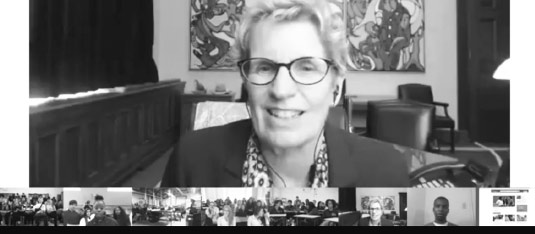Premier tackles youth employment questions using Google+
 CREDIT: YOUTUBE.COM/USER/PREMIEROFONTARIO
CREDIT: YOUTUBE.COM/USER/PREMIEROFONTARIOPremier Kathleen Wynne chatted with five high schools across Ontario to answer questions about youth and employment.
In mid-October, Ontario Premier Kathleen Wynne held her first-ever Google Hangout and invited some high school students from the province to answer questions about the government's Youth Jobs Strategy.
Wynne met the students through the Skype-like video chat and divulged how the government is helping youth find job placements, to learn new skills and/or spark interest in entrepreneurship.
“It doesn't happen that frequently that [the government and students] can have a direct conversation,” Wynne said to the students. “[Students] can talk to teachers, guidance counsellors and people in the community [to] give them feedback on what support [they need].”
The Strategy allocates $295 million into helping youth to “develop career skills, find employment or be their own boss,” according to a government document.
The largest portion ($195 million) of the Strategy covers the Youth Employment Fund, which provides incentives for employers to hire young people into four- to six-month placements.
“It allows employers to get a subsidy of up to $6,800 to hire a young person to work in their businesses,” said Wynne. “That provides greater opportunities in a whole range of sectors for young people to get connected to the sector they're trained in.”
The placements allow youth to gain experience while determining if there is interest in the field.
It's also perfect for people who are unsure of a career path, and according to Wynne.
“It's about going into something and deciding if it's something you want to do with your life,” she said. “But it's also about eliminating things that you may not want to do as well.”
Wynne recounted her own career path during the chat. “I didn't know I was going to be in politics when I was 16 years old,” she said. “But as you watch for doors to open, you never know where you're going to end up.”
The government hopes to help employ 25,000 youth in placements.
A lump sum of $25 million is dedicated to the Youth Skills Connection Fund, finding skills gaps and introducing training programs to bridge the gaps.
The Skills Connection Fund will partner the government with industries, not-for-profits and educators to do just that.
“We have a number of jobs that we don't have the people to fill,” said Wynne. “We're hoping that through this job strategy ... [we] will connect young people to the skills. We'll provide the training that will allow them to take part in an area that they might not have thought of before.”
“That way, we will open up a market for skills and young people to fill jobs that are available.”
Lastly, $45 million is devoted to the Youth Entrepreneurship Fund, helping high school and post-secondary students spark an interest in opening their own businesses.
“It's about launching their own businesses. [We want to] help young people create jobs themselves,” Wynne said. “The [fund] is about that, helping young people to think about things that they might want to do and support them in creating those jobs themselves.”
Wynne closed in saying what jobs of the future are going to be is unclear, and that people will need skills to transfer from job to job.
“What we do know is that [youth] are probably going to have more than one, two, three careers in [their] lives,” she said. “You're probably going to move into different kinds of work, depending on where you start out, your aptitudes.”
Find out more about the Youth Jobs Strategy at ontario.ca/youthjobs.













